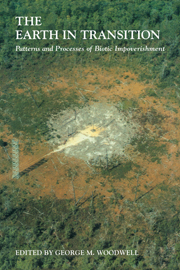Book contents
- Frontmatter
- Contents
- Preface
- Acknowledgments
- List of Contributors
- Part I Global Change and the Patterns of Impoverishment
- 1 The Earth under Stress: A Transition to Climatic Instability Raises Questions about Patterns of Impoverishment
- 2 The Experimental Impoverishment of Natural Communities: Effects of Ionizing Radiation on Plant Communities, 1961 – 1976
- 3 Air Pollution and Temperate Forests: Creeping Degradation
- 4 The Long-Term Effects of Air Pollutants on Lichen Communities in Europe and North America
- 5 Biotic Impoverishment in Northern Peatlands
- 6 Climatic Change and the Survival of Forest Species
- 7 The Atmosphere and the Future of the Biosphere: Points of Interactive Disturbance
- Part II Chronic Disturbance and Natural Ecosystems: Forests
- Part III Chronic Disturbance and Natural Ecosystems: Woodlands, Grasslands, and Tundra
- Part IV Chronic Disturbance and Natural Ecosystems: Aquatic and Emergent Ecosystems
- Part V Conclusion: Steps toward a World That Runs Itself
- Name Index
- Subject Index
7 - The Atmosphere and the Future of the Biosphere: Points of Interactive Disturbance
Published online by Cambridge University Press: 24 November 2009
- Frontmatter
- Contents
- Preface
- Acknowledgments
- List of Contributors
- Part I Global Change and the Patterns of Impoverishment
- 1 The Earth under Stress: A Transition to Climatic Instability Raises Questions about Patterns of Impoverishment
- 2 The Experimental Impoverishment of Natural Communities: Effects of Ionizing Radiation on Plant Communities, 1961 – 1976
- 3 Air Pollution and Temperate Forests: Creeping Degradation
- 4 The Long-Term Effects of Air Pollutants on Lichen Communities in Europe and North America
- 5 Biotic Impoverishment in Northern Peatlands
- 6 Climatic Change and the Survival of Forest Species
- 7 The Atmosphere and the Future of the Biosphere: Points of Interactive Disturbance
- Part II Chronic Disturbance and Natural Ecosystems: Forests
- Part III Chronic Disturbance and Natural Ecosystems: Woodlands, Grasslands, and Tundra
- Part IV Chronic Disturbance and Natural Ecosystems: Aquatic and Emergent Ecosystems
- Part V Conclusion: Steps toward a World That Runs Itself
- Name Index
- Subject Index
Summary
Editor's Note: The world is changing rapidly under human influences and the changes are the enemy of life. The seriousness of the problem has remained buried until recently in the litter of aspirations for economic growth at any cost and in the convenient and comforting assumption that the biosphere is resilient, capable of absorbing any insult. Recognition of biotic impoverishment as pervasive, even global, and as a threat to economic and political security as serious as war itself is new, not yet a part of the body politic. Yet, for the environment as for any machine, once parts start breaking, damage spreads rapidly.
Michael Oppenheimer offers a physical scientist's review of the physical and chemical changes under way in our world. Although it is common to acknowledge that “everything is connected to everything else”, we rarely recognize the concatenation of physical, chemical, and biotic changes in environment that make a term such as “acid rain” a reality. The complexities acknowledged by Bormann in his assertion that the decline of forests in eastern North America is not simply and certainly ascribed to air pollution become real in Oppenheimer's discussion of the mechanisms.
The effects of changes in environment appear in plants, not as a simple response to drought or heat or toxins such as ozone, but as an increase in insect or fungal damage in trees, a mysterious chlorosis, or unexplained mortality.
Repairing a troubled world will require fundamental alterations in many aspects of human behavior.
- Type
- Chapter
- Information
- The Earth in TransitionPatterns and Processes of Biotic Impoverishment, pp. 111 - 130Publisher: Cambridge University PressPrint publication year: 1991



